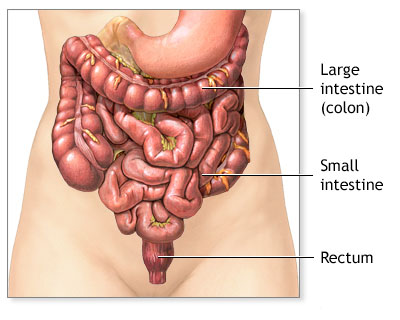Yersinia Pseudotuberculosis
Contents
When to Call Your Pediatrician
General Information
Yersinia enterocolitica and Yersinia pseudotuberculosis are bacterial infections that can cause problems when they occur. Y enterocolitica causes a condition called enterocolitis, which is an inflammation of the small intestine and colon that occurs, and often recurs, mostly in young children.

Figure: Your small intestine is the longest part of your digestive system - about twenty feet long! It connects your stomach to your large intestine (or colon) and folds many times to fit inside your abdomen. Your small intestine does most of the digesting of the foods you eat. It has three areas called the duodenum, the ileum, and the jejunum.
These infections appear to be acquired by eating contaminated food, particularly raw or inadequately cooked pork products, and drinking unpasteurized milk. They might also be contracted by touching an infected animal, drinking contaminated well water, or on rare occasions, from contaminated transfusions. The infections are increasing in frequency among children whose immune system is weakened. The incubation period is around 4 to 6 days.
Signs and Symptoms
When a Y enterocolitica infection is present, it not only causes an inflamed small intestine and colon, but also symptoms such as diarrhea and a fever. A child with this infection may have stools that contain blood and mucus. These symptoms may last for 1 to 3 weeks, sometimes longer.
Along with these more common symptoms, very young children who have too much iron stored in their bodies, such as those who receive blood transfusions, or whose immune system is already suppressed or weakened because of another illness, may be susceptible to bacteremia (the spread of bacteria to the blood). Older youngsters may also have symptoms that mimic appendicitis (a pseudoappendicitis syndrome), with right-sided abdominal pain and tenderness. On rare occasions, this infection may be associated with conditions such as a sore throat, eye inflammation, meningitis, and pneumonia. In older youngsters, joint pain or a red skin lump (erythema nodosum) on the lower legs may develop after the infection itself has gone away.
Children with Y pseudotuberculosis will likely develop a fever, a rash, and abdominal pain, including the pseudoappendicitis syndrome. Some children may also have diarrhea, a rash, and excess fluid in the chest region or spaces around the joints.
When to Call Your Pediatrician
Contact your pediatrician if your child’s stool is streaked with blood. Look for signs of dehydration that could be caused by your youngster’s diarrhea, including dry mouth, unusual thirst, and a decline in the frequency of urination.
How Is the Diagnosis Made?
Your pediatrician can order tests to detect the presence of Yersinia organisms in your child’s stool. Evidence of the infection may also be seen by taking throat swabs and evaluating them in the laboratory, examining the urine, or testing the blood for antibodies to the bacteria.
Because these are relatively rare infections, most laboratories do not routinely perform tests looking for Yersinia organisms in feces.
Treatment
In most children, the infection will go away on its own. In some cases, Yersinia infections need to be treated with antibiotics. As with all cases of diarrhea, fluids are given to prevent or treat dehydration.
Prevention
Make sure your child does not consume raw or undercooked pork, unpasteurized milk, and contaminated water.Wash your hands thoroughly with soap and water after handling raw pork intestines (chitterlings).
No vaccine is available to prevent Yersinia infections.

